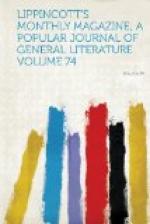But it is the want of written language, and the obstacles in the way of its acquirement, which constitute the chief disability of the deaf mute in the attempt to gain an education. If you set a child of seven years of age to learn Greek, requiring him to receive and express his ideas wholly in that language, you would not hope for any very clear expression of those ideas with less than a year’s instruction, nor would you expect him to appreciate the delicate beauties of the Odyssey in that length of time. The progress of the deaf mute in any language, even the most simply constructed, is greatly slower than that of the hearing child. The latter is assisted at every step by his previous knowledge of his vernacular. The former does not think in words, as you have done from your earliest recollection. Undertake to do your thinking in a foreign tongue, of which you have but a limited knowledge: the attempt is discouraging. The deaf mute thinks in signs. This, his only vehicle of thought, is a hindrance instead of a help in learning written language, there being no analogy whatever between the two methods of expressing ideas.
With these tremendous odds against him the deaf-mute child is set to the task of acquiring a knowledge of written language. His ideas (in signs) shape themselves in this wise: “Horses, two, run fast.” Of course he does not think these words. The idea of a horse, its shape and color, is probably imaged in his mind, or if the horse be not present to his sight, the sign which he uses for that animal comes into his thought. He next touches or grasps or holds up two of his fingers, which he uses on all occasions to express number. Then the idea of running by means of its sign, and lastly that of speed, suggest themselves, the last two, however, being probably closely connected, as in our own minds.
Observe, here, that the order in which the thoughts arrange themselves is different from the manner of those who think by means of words. The main idea is “horse,” and he gives it the preference, as the older and more simply constructed languages always did. It is reserved for our cultured and perfected language to describe an object before telling what that object is. Who will say that it is according to philosophical principles that we say, “A




